Style
An Opulent New Kimono Exhibition at the Metropolitan Museum of Art Interweaves History, Craftsmanship, and Contemporary Fashion
"Kimono Style: The John C. Weber Collection" traces the thread from feudal Japan to 20th-century design.
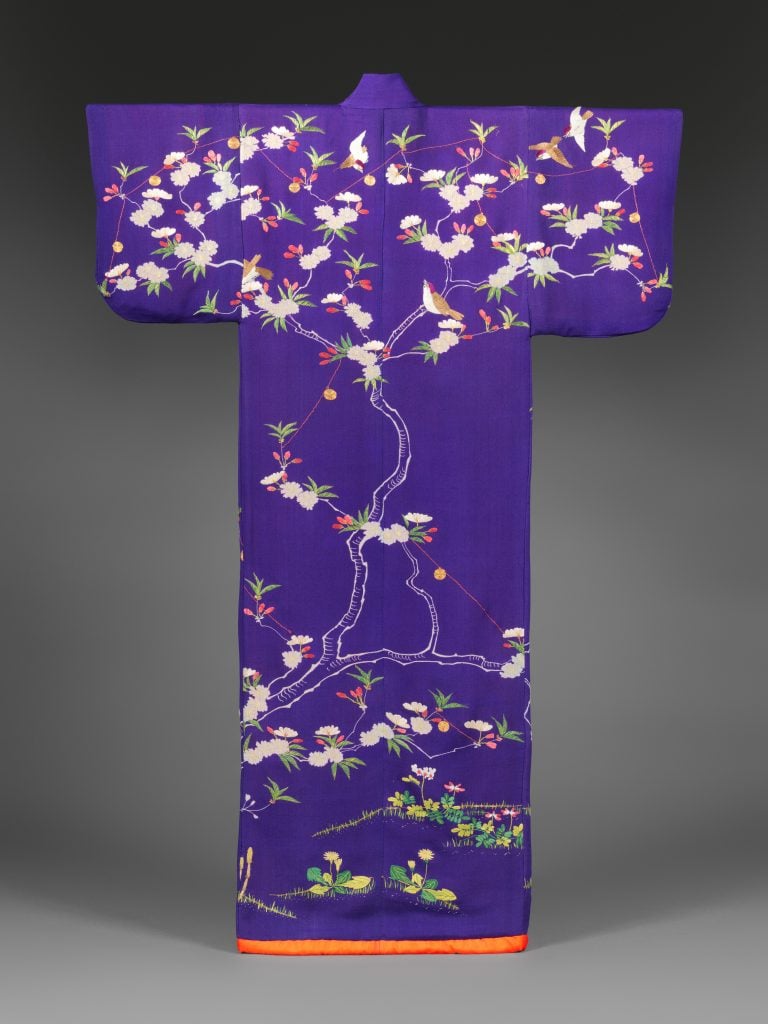
"Kimono Style: The John C. Weber Collection" traces the thread from feudal Japan to 20th-century design.

William Van Meter

Fashion, once shunned by serious museums, has in recent decades seemed to overtake them. But despite the wealth of source material, stellar exhibits are hard to come by: For every “Savage Beauty,” there are ten brand activations masquerading as art pop-ups. But in a new exhibition devoted to kimonos within the Japanese galleries of New York’s Metropolitan Museum of Art, it’s clear that we’re not just seeing clothes, but art rendered in silk and gold thread.
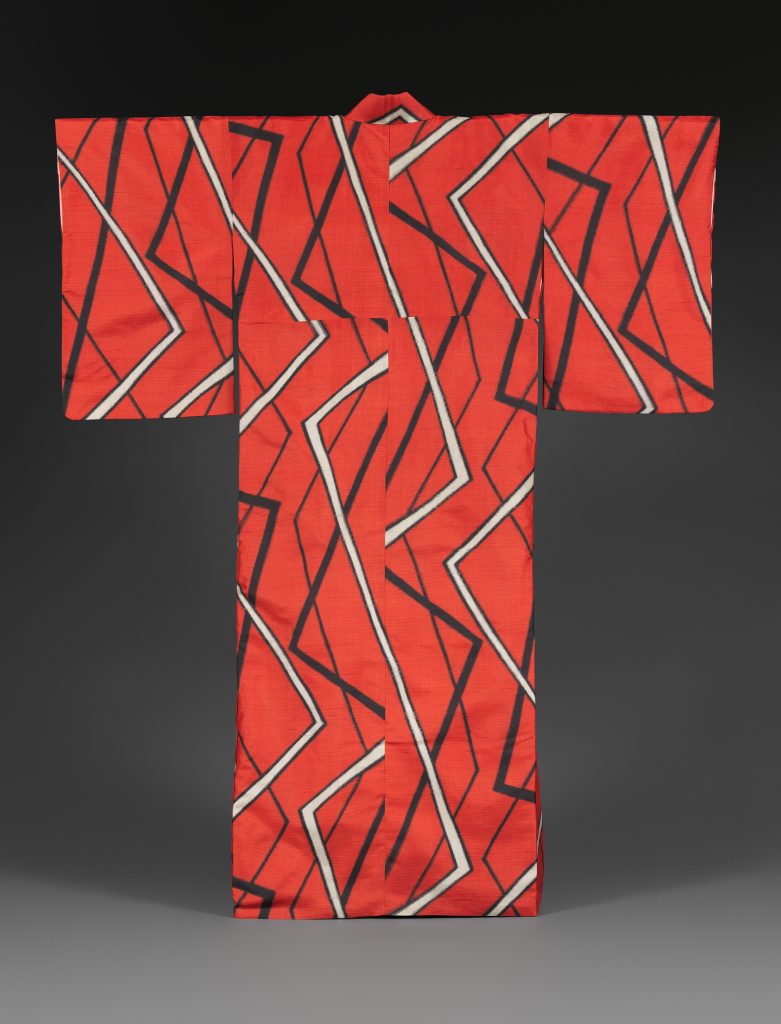
Meisen kimono with thunderbolts. Shōwa period (1926–89), ca. 1950–55. Plain-weave silk in double ikat (heiyō-gasuri). Promised gift of John C. Weber. Photo: Paul Lachenauer; courtesy of the Metropolitan Museum of Art.
The just-opened “Kimono Style: The John C. Weber Collection” comprises more than 60 exquisite examples of these garments. It is much more than a fashion exhibition, encompassing both craftsmanship and the gravitas of Japanese history. Kimonos are steeped in narrative, meaning, and ritual.
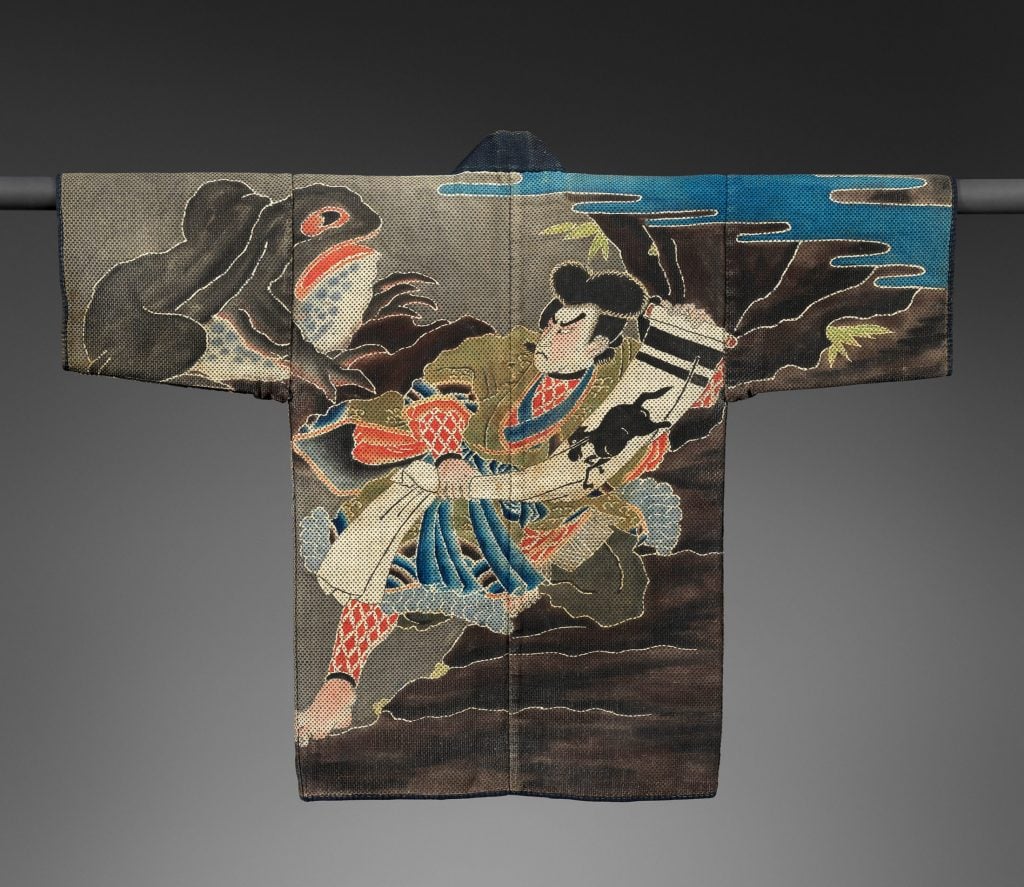
Fireman’s jacket (hikeshi-banten) with Shogun Tarō Yoshikado. Edo period (1615–1868), mid 19th century. Quilted cotton with tube-drawn paste-resist dyeing (tsutsugaki) with hand-painted details. John C. Weber Collection. Photo: Paul Lachenauer; courtesy of the Metropolitan Museum of Art.
As Monika Bincsik, associate curator for Japanese decorative arts, noted in a statement, “The kimono has served for centuries as a tableau on which to describe and record the histories of women. The variety of patterns and colors and the often-changing trends reveal much about Japanese culture and society.”
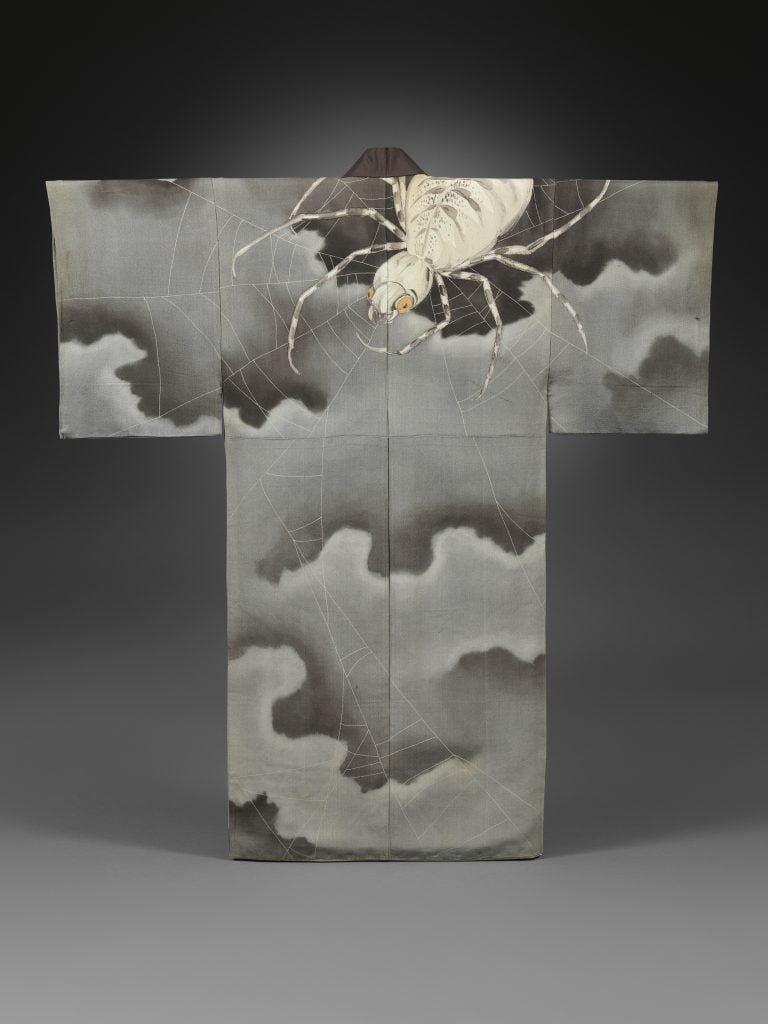
Man’s under-kimono (nagajuban) with spider and spiderweb. Taishō (1912–26) to Shōwa (1926–89) period, ca. 1920s–30s. Crepe silk (chirimen) with freehand paste-resist dyeing (yūzen). Promised gift of John C. Weber. Photo: Paul Lachenauer; courtesy of the Metropolitan Museum of Art.
Some kimonos are splendidly graphic, Op Art masterpieces that appeared generations ahead of time. Others depict myths or glimpses of everyday life in labyrinthine embroidery. They signal status and power. The Edo period (1615–1868) is most represented, but the show segues to more modern iterations and periods (also on display are hanging scrolls, wood-block prints, and various other pieces of clothing, art, and antiquities).
It’s hard to narrow the standout ensembles. Male and female samurai firefighter uniforms come to mind, as well as a men’s crepe silk under-kimono (a nagajuban) adorned with a cartoonlike spider and looks like modern anime.
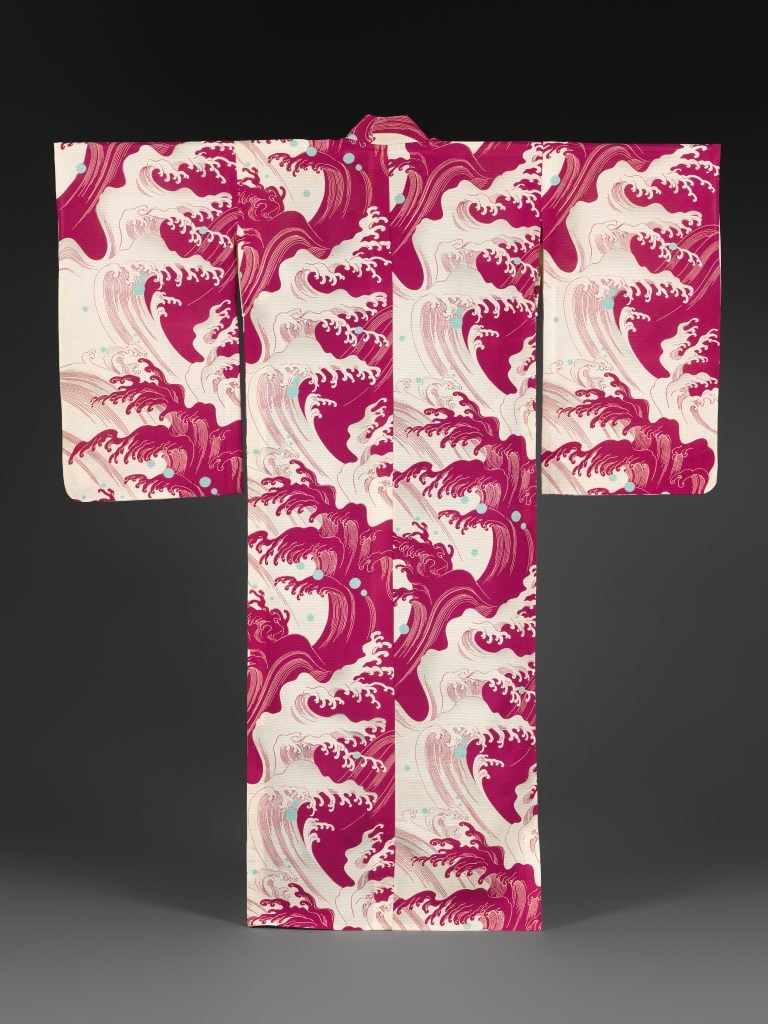
Summer kimono (hito-e) with waves and water drops. Taishō (1912–26) to Shōwa (1926–89) period, ca.1920s–30s. Printed gauze-weave (ro) silk. Promised gift of John C. Weber. Photo: Paul Lachenauer; courtesy of the Metropolitan Museum of Art.
The other part of the exhibition may draw in a different kind of museumgoer. The Met’s Costume Institute supplies the fashion design angle to the show, with some kimono-inspired Japanese and Western designers. This portion is less of an immediate visceral knockout, but still scores.
The 20th-century Japanese designers are, of course, masters of the national uniform. They deftly weave a kimono facet into their contemporary concepts. Kansai Yamamoto’s 1993 kabuki bomber jacket is an elaborate nod to the embroidered storytelling of traditional kimonos, while Yohji Yamamoto’s 1983 black cotton coat is a study in proportion to the one-piece garment.
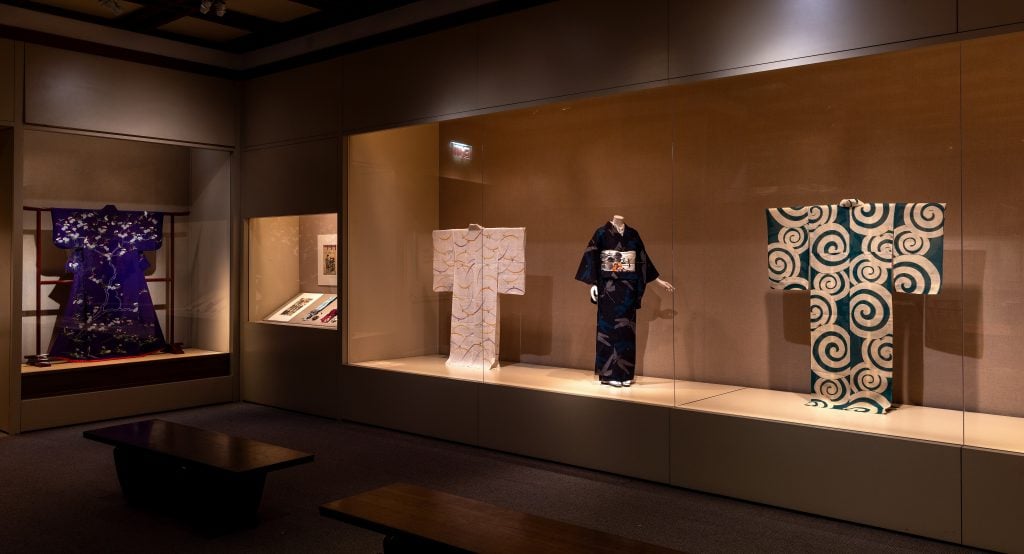
Installation view, “Kimono Style: The John C. Weber Collection.” Photo: Bruce Schwarz, courtesy of the Metropolitan Museum of Art.
The Western designers are presented as having even more restraint, although they made much grander kimono-inspired gestures in their work. Alexander McQueen and John Galliano churned out many of their own kimonos in their heyday, sending models down the runway LARPing as geisha. One might expect to see, therefore, kimonos from McQueen’s winter 1997 Givenchy couture or Galliano’s spring 2007 Dior couture collections. But the curators veered from outright Japonica, instead highlighting more subtle inspirations—less culturally appropriative, but also less apparent in the aesthetic links. This savvy reframing may have been inspired by the backlash to the Victoria & Albert’s 2020 exhibition “Kimono: Kyoto to Catwalk.“
Galliano is represented by an impressively constructed Maison Margiela dress in cream with a royal blue obi-like sash in the back. The show notes explain that a 1998 McQueen ensemble is present “because the trailing sleeves, which connect at the back, evoke the long sleeves of the furisode, the formal kimono for unmarried young women.” Thom Browne manages to squeeze in another Met appearance—pairing his high-water suit with geta sandals. And while the Cristobal Balenciaga dresses are masterpieces of form and volume, they don’t really scream “kimono.” Yet all these components make sense, for the most part, with some delving and explanation.
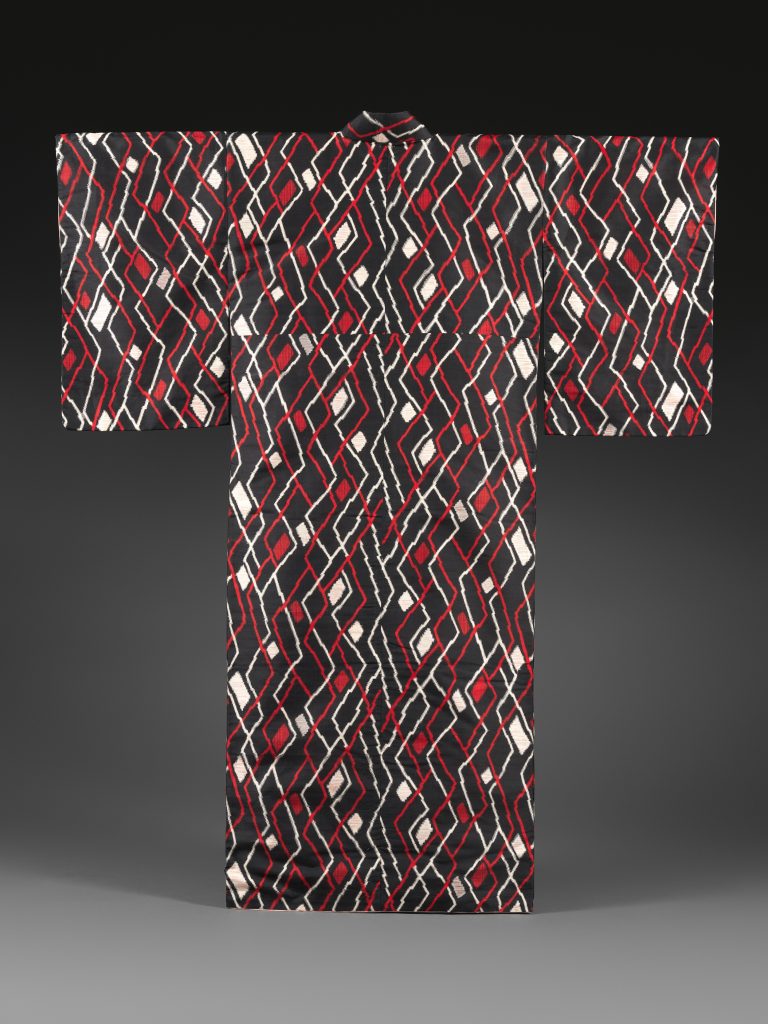
Meisen kimono with diamond patterns. Shōwa period (1926–89), ca. 1950–55. Plain-weave silk warps with machine-spun silk wefts in double ikat (heiyō-gasuri). Promised gift of John C. Weber. Photo: Paul Lachenauer; courtesy of the Metropolitan Museum of Art.
All that said, everything sure is swell to admire, even if the two halves aren’t necessarily cohesive. In fact, the juxtaposition heightens that euphorically disorienting, time-traveling sensation you can get from viewing a show—when you’re lucky.
“Kimono Style: The John C. Weber Collection” is on view through February 20, 2023, at the Met Fifth Avenue’s Arts of Japan galleries, 1000 Fifth Avenue, New York, NY 10028.